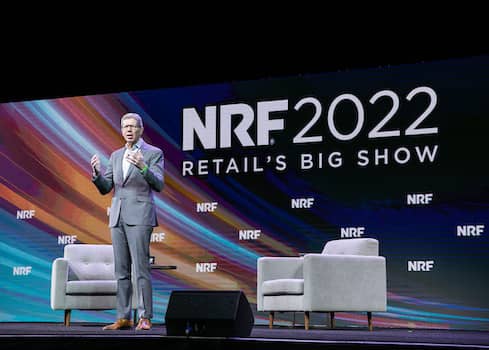Retailers in the pandemic have faced a pivot to ecommerce, supply chain problems, labor shortages, and inflation. Here's what they can expect in 2022.

Hybrid shopping and increasing the speed of data and analytics operations were among the topics at top of mind as retail business executives returned to the Javitz Center in New York City for the first time in two years for the National Retail Federation’s Big Show.
But in spite of the return to the in-person venue, the pandemic and retail’s response to it remained central to the event’s themes. Indeed, even with COVID precautions such as proof of vaccination required, many tech vendors pulled out of in-person participation at the last minute due to the predicted Omicron variant surge coinciding with the event’s mid-January dates.
“Together, we have come through a remarkable set of challenges,” said Mike George, departing NRF chairman of the board in his keynote address. “In 2020, the pandemic put the world on hold but retail never stopped. We kept moving forward, striving and evolving to meet the rapidly changing needs of our customers and communities.”
Though we may all be weary, that evolution continues as retailers prepare to leverage technology to address a fresh set of challenges in 2022, along with the ongoing challenges of the pandemic, the pivot to ecommerce, and supply chain issues, and more.
How Consumer Habits Have Changed
A new survey from NRF and IBM Institute for Business Value shows that more consumers (27% of all consumers and 36% of Gen Z) are turning to “hybrid shopping,” a blend of physical and digital channels.
George said that “the older generation reports that they are more comfortable now with buy online, pick up in store, or pick up at curbside. They are more comfortable with online grocery ordering. There’s no turning back to the way things were pre-pandemic.
Indeed, 58% of all consumers say they have used in-store self-checkout and they plan to continue using it, and 50% say they have used order online, pick up at the store. Another 47% say they have used mobile contactless payment.
Pain Points for Retailers
Successful retailers have pivoted to meet the challenge of hybrid orders, but there are still many pain points, according to Rob Saker, global head of retail and manufacturing at Databricks, a cloud-based data, AI, and analytics platform. It’s been two years since the pandemic hit and retailers scrambled and invested in ecommerce ordering to in-store and delivery fulfillment.
“Now retailers are in this situation of in-between. We’re reopening but the growth rate of ecommerce as a percentage of revenue has decreased and many retailers are struggling with profitability on that ecommerce fulfillment and delivery,” he tells InformationWeek.
Combine that with ongoing supply chain bottlenecks, inflation, and labor shortages, and you start to get a sense of what retailers are facing for 2022.
In terms of technology, “Many of the systems that companies have built their operations on are too slow to support the challenges of retail,” Saker says. “There’s a lot of latency, and latency leads to added costs.”
Improving these back-end operations will be a major focus in 2022. But there are some benefits that will come from that work.
Leveraging Data and Analytics
For instance, a major benefit of all the additional ecommerce comes in the form of additional data about customers and their preferences. Retailers are now positioned to get a better view of customer preferences and spending habits and use the information to provide a better customer experience through sales, marketing, and forecasting so that key items don’t go out of stock.
A challenge in leveraging all this data can be the lack of a that single source of truth, said Katy Campbell, senior manager for analytics delivery at the air mattress manufacturer and retailer Sleep Number, during a virtual session at NRF.
“This [single source of truth] has been an ongoing struggle for us and I think a lot of companies,” Campbell said. Sleep Number is a new customer of analytics company SAS. “We have tons of sources of data -- our own, plus third-party data -- and we had a lot of business users who were building their own data lakes in different tools using different strategies.” That meant that different groups were drawing different conclusions from the same data.
“One of our big goals has been to curate all of that data together into one place,” Campbell said. Another big goal is to improve decision making in the company. The consumer product company wants to set up an enterprise analytics center of excellence that will enable them to move beyond business intelligence and reports to use the platform for everything from product design, product ideation, sales, planning, and customer service, according to Dan Mitchell, SAS director of global retail.
Retail Clouds
Microsoft and Google both used the NRF event to showcase their industry clouds for retail. Microsoft announced February 1 general availability of its Microsoft Cloud for Retail, a set of retail-specific capabilities collected in the Microsoft cloud, including a way to unify disparate data sources, according to Microsoft. The company said that in 2022 this industry-specific cloud will help retailers maximize the value of retail data, improve their customers’ shopping experiences, build a sustainable and real time supply chain, and help empower store associates.
In a blog post that coincided with NRF, Google recommended retailers harness data and AI for demand forecasting with its Vertex AI solution and highlighted additional technologies designed to help retailers compete in a turbulent market.
Rising to the Challenge
“While we all fervently hope, as Omicron begins to peak across the country, that we’ll find the worst days of this are behind us, it’s still hard to predict what the virus might have in store for us in 2022,” said George in his keynote. “Yet we enter the year with great confidence because we have all shown tremendous agility over the past two years proving our ability to deliver safe, convenient, and yes, inspiring shopping in the face of unprecedented challenges.
What to Read Next:
Retailers Choose Tech Upgrades Over Holiday Magic in 2021
Data Analytics Can Fix the Supply Chain. Eventually
About the Author(s)
You May Also Like







